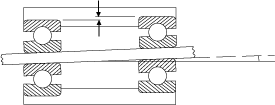| Available Bearings | Bearing Selector | Technical Info | New Products | |||
Bearing Mounting and Fitting: Bearing Failure Due to Bearing Force, Moisture, and/or Poor Alignment || Dynaroll Bearing Design Factors Part 2
TECHNICAL PAPERS
Inch Precision
Metric Precision
600 Series
6000 Series
6200 Series
6300 Series
6800 Series
6900 Series
R Series
Thrust Bearings
Stainless Steel Thrust Bearings
Thin Section Bearings
Collar Bearings
Flangette Collar Bearings
Specify by Type
Specify by Desired Dimensions
Specify by Cross-Reference
Specify by Known Part Number
Part Numbering System
TECHNICAL PAPERS
DESIGN FACTORS WHEN USING SMALL BEARINGS, PART 2: MOUNTING AND FITTING (Page 10)
Avoid excessive force: The most common cause of small bearing failure is excessive force applied during assembly, which usually results in noise, higher torque, raceway damage, etc. Excessive forces during assembly of small bearings are usually generated by poor handling techniques or incorrect/uncontrolled interference due to poor design or tolerance stack up.
Avoid moisture and high humidity: Bearings are susceptible to corrosion and should be kept in a dry environment. The lubricant in a bearing will provide some measure of corrosion resistance to the internal raceways, but the acid from skin can corrode the outer surfaces. 52100 chrome steel bearings will quickly corrode if the lubricant is cleaned out, so bearings made from this material should never be used dry. Bearings must be aligned in an
assembly: Misalignment during assembly is a common cause
of  ½
Must be < uf ½
Must be < uf
This is the second article in a series
of four on design factors when using small bearings.
|

